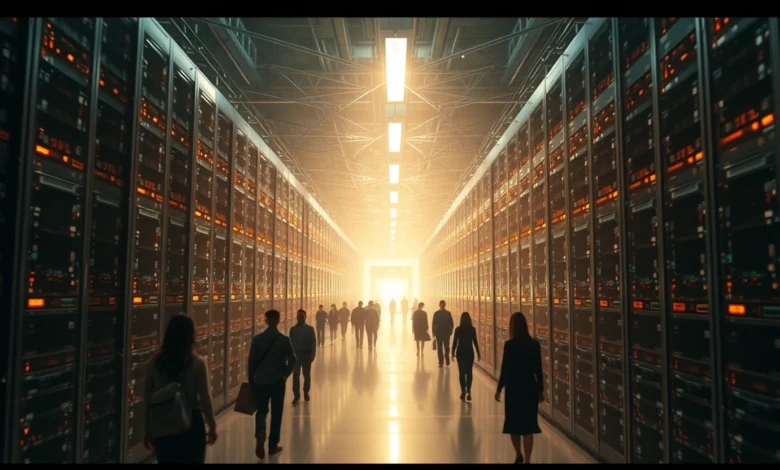What No One Tells You About the $100 Billion OpenAI-Nvidia AI Chip Deal: The Environmental Cost & Regulatory Backlash

The Unprecedented Race: Unpacking the Future of AI Compute Infrastructure
Introduction to the AI Compute Arms Race
The world is witnessing an unprecedented race for artificial intelligence, and at its core lies the foundational pillar of AI compute infrastructure. Simply put, this refers to the vast network of specialized hardware, sophisticated software, and interconnectivity that provides the computational muscle necessary to train, develop, and deploy AI models. Think of it as the nervous system and brain of the artificial intelligence revolution – without it, AI cannot think, learn, or act. From the powerful graphics processing units (GPUs) that accelerate machine learning to the vast networks of data centers housing these machines, every component is crucial.
As AI models grow exponentially in complexity and capability – particularly large language models (LLMs) and generative AI – the demand for computational power has escalated to staggering levels. What once required a single server might now necessitate entire clusters, or even dedicated facilities, running around the clock. This relentless pursuit of more processing power, faster data transfer, and greater storage capacity has ignited a fierce competition among tech giants and nations alike.
The current landscape is one of rapid expansion, marked by significant AI investment and aggressive development strategies from major players like OpenAI, Google, Microsoft, and Nvidia. They are not just building bigger computers; they are designing entirely new ecosystems tailored for the unique demands of AI. This global \”AI compute arms race\” isn’t merely about technological one-upmanship; it’s about securing future economic leadership, driving scientific discovery, and shaping the very fabric of society. Understanding this infrastructure is key to grasping the trajectory and potential of AI itself.
The Foundations: Why AI Compute Infrastructure is Now Critical
The insatiable demands of modern AI models are the primary drivers making AI compute infrastructure an absolutely critical domain. Large Language Models (LLMs), for instance, require billions, sometimes even trillions, of parameters to be trained on colossal datasets. This process is incredibly computationally intensive, pushing existing hardware to its limits and necessitating entirely new paradigms of computing. Without this underlying power, the sophisticated applications we see today—from advanced natural language processing to groundbreaking image generation—would simply not be possible.
Perhaps the most ambitious project highlighting this criticality is OpenAI Stargate. This isn’t just a minor expansion; it’s a visionary initiative to construct a series of massive, dedicated data centers across the United States. Reports indicate plans for up to five new facilities, aiming for a combined capacity of nearly 7 gigawatts, with strategic partnerships already forged with industry giants like Oracle and SoftBank [1]. Beyond this, OpenAI has also announced a colossal $100 billion strategic alliance with Nvidia to deploy an additional 10 gigawatts of data center capacity [3]. This scale is unprecedented, mirroring the energy output of several large nuclear reactors, and underscores CEO Sam Altman’s conviction that truly advanced AI requires a fundamental transformation in infrastructure.
At the very heart of this transformation lies the indispensable role of Nvidia AI chips. For years, Nvidia’s GPUs (like the forthcoming Vera Rubin GPUs mentioned in the OpenAI partnership) have served as the backbone of AI development, providing the parallel processing power essential for deep learning. These chips are not merely faster processors; they are highly specialized engines designed to handle the complex mathematical operations inherent in AI training and inference. The ongoing innovation in Nvidia AI chips ensures that as AI models become more sophisticated, the hardware keeps pace, making Nvidia an undeniable linchpin in the global AI compute infrastructure build-out.
Megatrends in AI Infrastructure Development
The current landscape of AI compute infrastructure development is defined by several megatrends that are reshaping the technology and economic spheres. Foremost among these is the sheer scale of AI investment. Billions, and even hundreds of billions, of dollars are flowing into the construction of new data centers and the procurement of cutting-edge hardware. Oracle, for example, is reportedly looking to raise $15 billion through corporate bond sales, fresh off a reported $300 billion deal to supply OpenAI with compute resources and ongoing talks with Meta for a $20 billion compute deal [2]. Such figures illustrate the immense capital commitment required to power the next generation of AI. Nvidia’s commitment to invest up to $100 billion into OpenAI’s infrastructure further underscores this unprecedented level of financial backing [3].
Another critical trend is the formation of strategic alliances and partnerships. The complex and capital-intensive nature of building out global AI compute infrastructure necessitates collaboration between different industry leaders. OpenAI’s partnerships with Oracle and SoftBank for its Stargate project, and the monumental alliance with Nvidia, are prime examples. These collaborations combine expertise in cloud computing, energy infrastructure, chip manufacturing, and AI model development, creating powerful ecosystems designed to accelerate progress.
Finally, this massive build-out has significant geopolitical implications, fueling a global race for AI dominance. Countries are increasingly viewing leadership in AI compute infrastructure as a matter of national security and economic future. The United States, with initiatives like Stargate, is actively vying to secure its competitive edge against rivals like China, which is also making rapid advancements in deploying AI infrastructure [1]. This competition extends beyond hardware, encompassing talent acquisition, regulatory frameworks, and ethical guidelines, making the future of AI not just a technological challenge, but a global strategic imperative.
Navigating the Complexities: Insights and Challenges
While the rapid expansion of AI compute infrastructure promises transformative advancements, it also presents a formidable array of complexities and challenges that demand careful consideration. One of the most pressing concerns is the staggering environmental and energy consumption demands. The new generation of data centers being planned for initiatives like OpenAI Stargate are projected to require multiple gigawatts of power, akin to the output of large-scale nuclear reactors [1]. This immense energy appetite raises serious questions about the sustainability of AI’s growth, its carbon footprint, and the strain it places on existing power grids. Finding greener energy solutions and optimizing efficiency will be paramount.
Another critical debate revolves around the scale versus efficiency dilemma. Is simply scaling up AI compute infrastructure—building ever-larger data centers and deploying more powerful Nvidia AI chips—the most effective path for advancing AI, or are efficiency breakthroughs equally, if not more, crucial? Some experts question whether pure scale will indefinitely guarantee performance improvements for large language models, suggesting that architectural innovations or more efficient algorithms could yield significant gains with fewer resources [1]. This discussion shapes investment strategies and research directions.
The consolidation of power within the AI compute infrastructure market has also attracted increasing regulatory scrutiny and antitrust concerns. When a few dominant players control essential resources—such as cutting-edge GPUs or massive cloud infrastructure—it raises questions about fair competition, market access, and the potential for monopolistic practices. Regulators are beginning to examine the intricate web of investments and partnerships, like Nvidia investing directly in AI developers such as OpenAI, to ensure a level playing field for innovation [3].
This brings us to the intriguing dynamic of circular investment. When hardware providers like Nvidia invest heavily into AI developers like OpenAI, it creates a symbiotic relationship that can accelerate development but also complicate market dynamics. While beneficial for driving innovation and securing vital resources, it can also raise questions about market lock-in, potential conflicts of interest, and the independent growth of smaller AI startups, making the future competitive landscape of AI compute infrastructure a complex puzzle.
Forecasting the Future of AI Hardware and Compute
The trajectory of AI compute infrastructure is set to evolve dramatically, shaping the very future of AI hardware and its capabilities. We can anticipate the continued, rapid innovation in Nvidia AI chips, with each new generation pushing the boundaries of processing power, memory bandwidth, and energy efficiency. Beyond raw power, future chips will likely integrate more specialized AI accelerators, optimized for specific neural network architectures and tasks, moving towards a more heterogeneous computing environment. However, Nvidia won’t be the sole player; the \”AI compute arms race\” will drive fierce competition, spurring innovations from AMD, Intel, and emerging startups.
A significant trend to watch is the diversification and development of custom silicon. Companies like OpenAI are actively exploring and reportedly working on their own custom AI chips [3]. This move aims to reduce reliance on single vendors like Nvidia, optimize hardware specifically for their unique AI models, and potentially achieve greater cost-effectiveness and performance gains. As AI models become more tailored, so too will the underlying hardware, leading to a vibrant ecosystem of specialized processors.
The long-term impact of robust AI compute infrastructure will be nothing short of transformative for innovation and economies. Just as the internet backbone catalyzed digital commerce and information sharing, this new compute fabric will accelerate AI advancements across all sectors. Imagine medical diagnoses improved by AI trained on unprecedented datasets, scientific discoveries made possible by complex simulations, or entirely new industries emerging from hyper-personalized AI services. This infrastructure will not only foster job creation in technical fields but also reshape industries by automating tasks, enhancing productivity, and enabling entirely new forms of creativity and problem-solving. It’s like building the superhighways and power grids for an entirely new, digitally intelligent civilization.
This necessitates an enduring AI investment wave, not just in chips and data centers, but across the entire stack—from networking and cooling solutions to advanced software and security protocols. The commitment to building this foundational layer will remain a strategic imperative for nations and corporations alike, as they race to define the capabilities and applications of tomorrow’s AI.
Your Role in the AI Compute Revolution
The profound transformation driven by advancements in AI compute infrastructure isn’t just for tech giants and researchers; it has implications for every organization and individual. For businesses, now is the time to critically assess your own AI compute infrastructure needs and strategies. Whether through cloud partnerships, on-premise solutions, or a hybrid approach, understanding how to access and leverage this computational power will be vital for maintaining competitiveness and unlocking new opportunities. Start by identifying specific AI initiatives that can drive value and then determine the compute resources required to bring them to fruition.
Furthermore, as this unprecedented expansion of data centers and future of AI hardware unfolds, there is a collective call for sustainable innovation. Stakeholders across the spectrum – from developers and policymakers to investors and consumers – must urge and adopt practices that address the environmental and ethical implications of this rapid growth. Prioritizing energy-efficient designs, sourcing renewable energy, and developing more resource-light AI algorithms are not just corporate responsibilities but critical steps towards a responsible and sustainable AI future.
To stay informed and engaged in this rapidly evolving landscape of future of AI hardware and AI compute infrastructure, we encourage you to continue exploring reputable AI news outlets, academic research, and industry reports. The decisions made today regarding the build-out of this foundational technology will reverberate for decades, shaping the very essence of human-AI collaboration and progress.
—
Related Articles:
* OpenAI’s Stargate Initiative and US AI Leadership
* Oracle’s $15 Billion Bond Sale and AI Deals
* OpenAI and Nvidia’s $100 Billion Chip Deal





